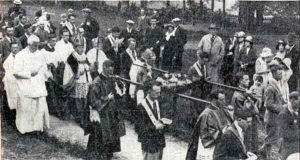.

The mission at Launceston was established in 1886 at Kensey Villa (the present presbytery below) by the Rev. Charles Baskerville Langdon an Anglican curate at St Mary’s Plympton before his conversion to Catholicism in 1883. This was also the year of the beatification of Cuthbert Mayne by Pope Leo XIII. In 1887 a temporary church and stables were built next door to the presbytery which also formed a bordering school. In 1911, the permanent Church of the English Martyrs, designed by Arthur Langdon, Charles Langdon’s brother, was erected. Built to a Byzantium style by local mason F. H. Nicholls of Lewannick, with carpentry by J. H. Harry, the oak doors by Mr Clifton of Ashwater, and the copper dome by T. Chapman (Junior) of Launceston. The Lady Chapel was added in 1933.


The pontifical high mass was celebrated by the Right Reverend John Kelly, Bishop of Plymouth.

In 1933 a Lady Chapel was added to the south side of the nave, and two years later Bishop Barrett consecrated the church, dedicating it to the newly-canonised St John Fisher and St Thomas More, and to the Blessed English Martyrs. In 1970 Pope Paul VI canonised the forty English martyrs, including Cuthbert Mayne, and the church was rededicated to St Cuthbert Mayne in 1977 and became the national shrine and quite fittingly, the Church contains the national shrine of the Blessed Cuthbert Mayne. The high altar was moved forward in the 1970s.
A familiar sight for many years was the cross that lit up across the valley and up to the town from the presbytery of the church. During the second world war, it was taken down and re-sited near the entrance of the church. Eventually, it was put back to its former position, where it continued to post its position to the town until a severe storm left the cross quite literally hanging by a thread and it had to be removed for safety. It was a former priest, Father Peter Webb who pioneered a replacement, and with the Catholic Women’s Guild providing the funds a new cross was blessed by Father Matthew McGauran in July 1984. Sadly the landmark no longer shines and has lain in darkness for many years.
The temporary, corrugated iron, church, stables, and the central bell turret and original decorative scheme have been removed. The presbytery has been altered in the late 1990s and a church hall has been incorporated to the rear of the building.
In 1921 Father R. A. McElroy instituted a pilgrimage to honour St. Cuthbert Mayne whereby his skull was paraded through the town to the Castle. This became an annual event which at one time attracted thousand’s to Launceston (below in 1922 and 1932 respectively). In later years the popularity of the event waned and today is no longer held (More images at the bottom of this page).
Above three images of St. Cuthbert Mayne Church shortly after its construction in 1911.


Above two images of St. Cuthbert Mayne Church from the 1930s.

St. Cuthbert Mayne pilgrimage procession gallery.
Visits: 280


















